Si Qin
Text2Grad: Reinforcement Learning from Natural Language Feedback
May 28, 2025Abstract:Traditional RLHF optimizes language models with coarse, scalar rewards that mask the fine-grained reasons behind success or failure, leading to slow and opaque learning. Recent work augments RL with textual critiques through prompting or reflection, improving interpretability but leaving model parameters untouched. We introduce Text2Grad, a reinforcement-learning paradigm that turns free-form textual feedback into span-level gradients. Given human (or programmatic) critiques, Text2Grad aligns each feedback phrase with the relevant token spans, converts these alignments into differentiable reward signals, and performs gradient updates that directly refine the offending portions of the model's policy. This yields precise, feedback-conditioned adjustments instead of global nudges. Text2Grad is realized through three components: (1) a high-quality feedback-annotation pipeline that pairs critiques with token spans; (2) a fine-grained reward model that predicts span-level reward on answer while generating explanatory critiques; and (3) a span-level policy optimizer that back-propagates natural-language gradients. Across summarization, code generation, and question answering, Text2Grad consistently surpasses scalar-reward RL and prompt-only baselines, providing both higher task metrics and richer interpretability. Our results demonstrate that natural-language feedback, when converted to gradients, is a powerful signal for fine-grained policy optimization. The code for our method is available at https://github.com/microsoft/Text2Grad
UFO2: The Desktop AgentOS
Apr 20, 2025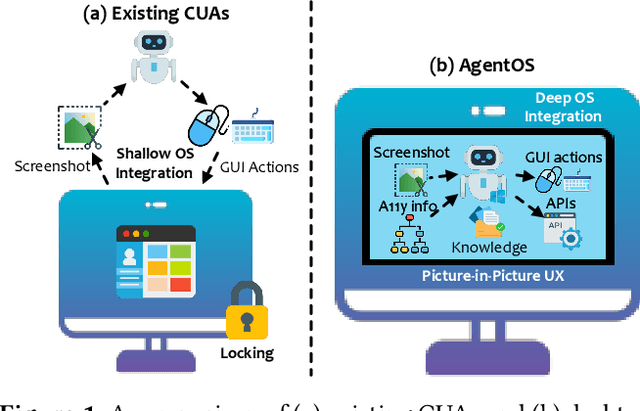
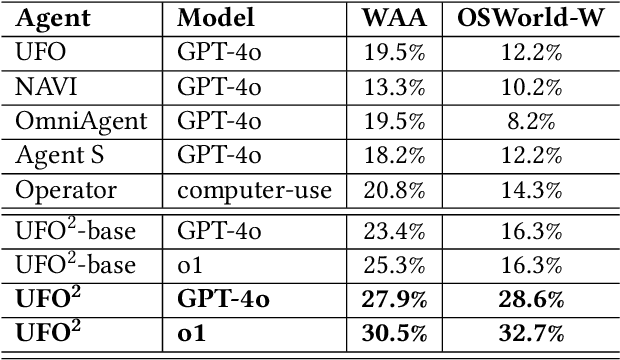
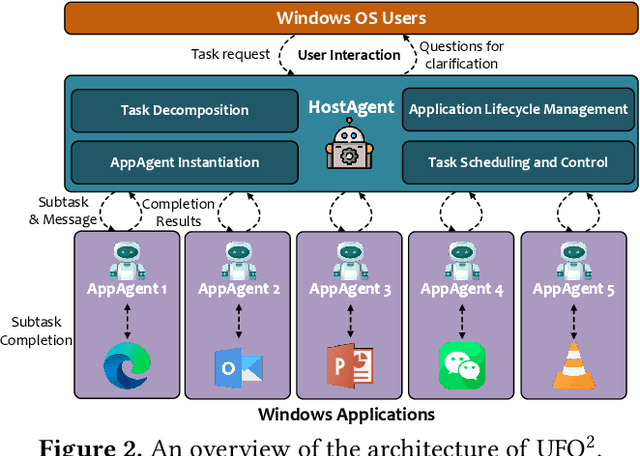

Abstract:Recent Computer-Using Agents (CUAs), powered by multimodal large language models (LLMs), offer a promising direction for automating complex desktop workflows through natural language. However, most existing CUAs remain conceptual prototypes, hindered by shallow OS integration, fragile screenshot-based interaction, and disruptive execution. We present UFO2, a multiagent AgentOS for Windows desktops that elevates CUAs into practical, system-level automation. UFO2 features a centralized HostAgent for task decomposition and coordination, alongside a collection of application-specialized AppAgent equipped with native APIs, domain-specific knowledge, and a unified GUI--API action layer. This architecture enables robust task execution while preserving modularity and extensibility. A hybrid control detection pipeline fuses Windows UI Automation (UIA) with vision-based parsing to support diverse interface styles. Runtime efficiency is further enhanced through speculative multi-action planning, reducing per-step LLM overhead. Finally, a Picture-in-Picture (PiP) interface enables automation within an isolated virtual desktop, allowing agents and users to operate concurrently without interference. We evaluate UFO2 across over 20 real-world Windows applications, demonstrating substantial improvements in robustness and execution accuracy over prior CUAs. Our results show that deep OS integration unlocks a scalable path toward reliable, user-aligned desktop automation.
API Agents vs. GUI Agents: Divergence and Convergence
Mar 14, 2025Abstract:Large language models (LLMs) have evolved beyond simple text generation to power software agents that directly translate natural language commands into tangible actions. While API-based LLM agents initially rose to prominence for their robust automation capabilities and seamless integration with programmatic endpoints, recent progress in multimodal LLM research has enabled GUI-based LLM agents that interact with graphical user interfaces in a human-like manner. Although these two paradigms share the goal of enabling LLM-driven task automation, they diverge significantly in architectural complexity, development workflows, and user interaction models. This paper presents the first comprehensive comparative study of API-based and GUI-based LLM agents, systematically analyzing their divergence and potential convergence. We examine key dimensions and highlight scenarios in which hybrid approaches can harness their complementary strengths. By proposing clear decision criteria and illustrating practical use cases, we aim to guide practitioners and researchers in selecting, combining, or transitioning between these paradigms. Ultimately, we indicate that continuing innovations in LLM-based automation are poised to blur the lines between API- and GUI-driven agents, paving the way for more flexible, adaptive solutions in a wide range of real-world applications.
Label Distribution Learning with Biased Annotations by Learning Multi-Label Representation
Feb 03, 2025Abstract:Multi-label learning (MLL) has gained attention for its ability to represent real-world data. Label Distribution Learning (LDL), an extension of MLL to learning from label distributions, faces challenges in collecting accurate label distributions. To address the issue of biased annotations, based on the low-rank assumption, existing works recover true distributions from biased observations by exploring the label correlations. However, recent evidence shows that the label distribution tends to be full-rank, and naive apply of low-rank approximation on biased observation leads to inaccurate recovery and performance degradation. In this paper, we address the LDL with biased annotations problem from a novel perspective, where we first degenerate the soft label distribution into a hard multi-hot label and then recover the true label information for each instance. This idea stems from an insight that assigning hard multi-hot labels is often easier than assigning a soft label distribution, and it shows stronger immunity to noise disturbances, leading to smaller label bias. Moreover, assuming that the multi-label space for predicting label distributions is low-rank offers a more reasonable approach to capturing label correlations. Theoretical analysis and experiments confirm the effectiveness and robustness of our method on real-world datasets.
Large Action Models: From Inception to Implementation
Dec 13, 2024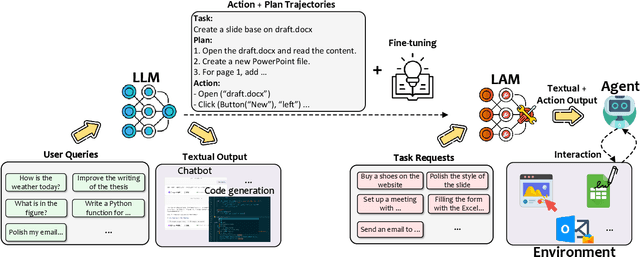

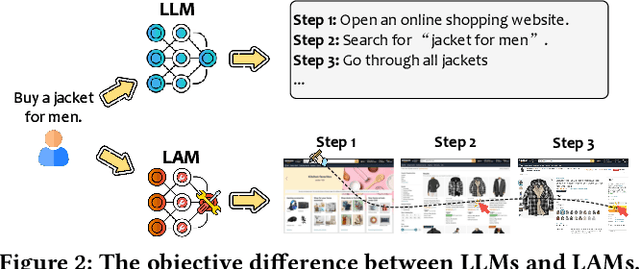

Abstract:As AI continues to advance, there is a growing demand for systems that go beyond language-based assistance and move toward intelligent agents capable of performing real-world actions. This evolution requires the transition from traditional Large Language Models (LLMs), which excel at generating textual responses, to Large Action Models (LAMs), designed for action generation and execution within dynamic environments. Enabled by agent systems, LAMs hold the potential to transform AI from passive language understanding to active task completion, marking a significant milestone in the progression toward artificial general intelligence. In this paper, we present a comprehensive framework for developing LAMs, offering a systematic approach to their creation, from inception to deployment. We begin with an overview of LAMs, highlighting their unique characteristics and delineating their differences from LLMs. Using a Windows OS-based agent as a case study, we provide a detailed, step-by-step guide on the key stages of LAM development, including data collection, model training, environment integration, grounding, and evaluation. This generalizable workflow can serve as a blueprint for creating functional LAMs in various application domains. We conclude by identifying the current limitations of LAMs and discussing directions for future research and industrial deployment, emphasizing the challenges and opportunities that lie ahead in realizing the full potential of LAMs in real-world applications. The code for the data collection process utilized in this paper is publicly available at: https://github.com/microsoft/UFO/tree/main/dataflow, and comprehensive documentation can be found at https://microsoft.github.io/UFO/dataflow/overview/.
Large Language Model-Brained GUI Agents: A Survey
Dec 03, 2024



Abstract:GUIs have long been central to human-computer interaction, providing an intuitive and visually-driven way to access and interact with digital systems. The advent of LLMs, particularly multimodal models, has ushered in a new era of GUI automation. They have demonstrated exceptional capabilities in natural language understanding, code generation, and visual processing. This has paved the way for a new generation of LLM-brained GUI agents capable of interpreting complex GUI elements and autonomously executing actions based on natural language instructions. These agents represent a paradigm shift, enabling users to perform intricate, multi-step tasks through simple conversational commands. Their applications span across web navigation, mobile app interactions, and desktop automation, offering a transformative user experience that revolutionizes how individuals interact with software. This emerging field is rapidly advancing, with significant progress in both research and industry. To provide a structured understanding of this trend, this paper presents a comprehensive survey of LLM-brained GUI agents, exploring their historical evolution, core components, and advanced techniques. We address research questions such as existing GUI agent frameworks, the collection and utilization of data for training specialized GUI agents, the development of large action models tailored for GUI tasks, and the evaluation metrics and benchmarks necessary to assess their effectiveness. Additionally, we examine emerging applications powered by these agents. Through a detailed analysis, this survey identifies key research gaps and outlines a roadmap for future advancements in the field. By consolidating foundational knowledge and state-of-the-art developments, this work aims to guide both researchers and practitioners in overcoming challenges and unlocking the full potential of LLM-brained GUI agents.
RuAG: Learned-rule-augmented Generation for Large Language Models
Nov 04, 2024



Abstract:In-context learning (ICL) and Retrieval-Augmented Generation (RAG) have gained attention for their ability to enhance LLMs' reasoning by incorporating external knowledge but suffer from limited contextual window size, leading to insufficient information injection. To this end, we propose a novel framework, RuAG, to automatically distill large volumes of offline data into interpretable first-order logic rules, which are injected into LLMs to boost their reasoning capabilities. Our method begins by formulating the search process relying on LLMs' commonsense, where LLMs automatically define head and body predicates. Then, RuAG applies Monte Carlo Tree Search (MCTS) to address the combinational searching space and efficiently discover logic rules from data. The resulting logic rules are translated into natural language, allowing targeted knowledge injection and seamless integration into LLM prompts for LLM's downstream task reasoning. We evaluate our framework on public and private industrial tasks, including natural language processing, time-series, decision-making, and industrial tasks, demonstrating its effectiveness in enhancing LLM's capability over diverse tasks.
An Advanced Reinforcement Learning Framework for Online Scheduling of Deferrable Workloads in Cloud Computing
Jun 03, 2024
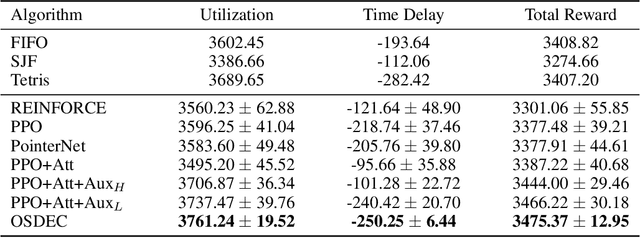
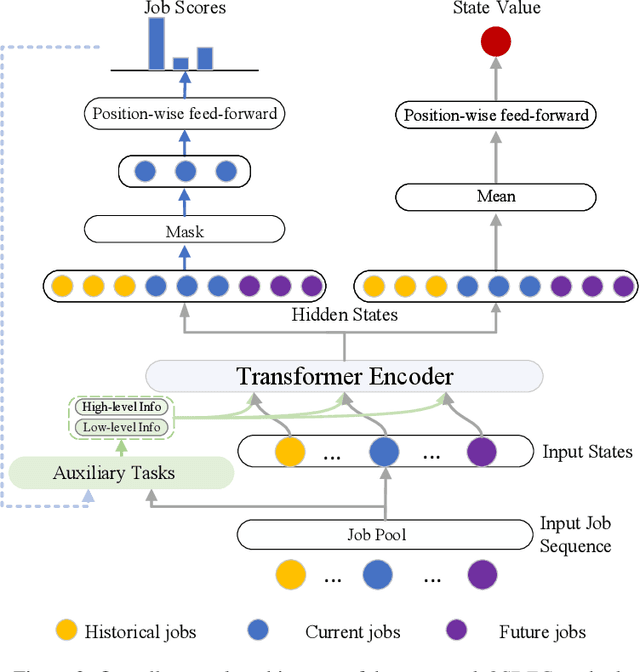
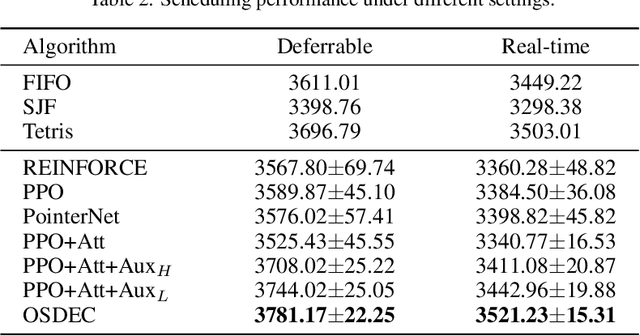
Abstract:Efficient resource utilization and perfect user experience usually conflict with each other in cloud computing platforms. Great efforts have been invested in increasing resource utilization but trying not to affect users' experience for cloud computing platforms. In order to better utilize the remaining pieces of computing resources spread over the whole platform, deferrable jobs are provided with a discounted price to users. For this type of deferrable jobs, users are allowed to submit jobs that will run for a specific uninterrupted duration in a flexible range of time in the future with a great discount. With these deferrable jobs to be scheduled under the remaining capacity after deploying those on-demand jobs, it remains a challenge to achieve high resource utilization and meanwhile shorten the waiting time for users as much as possible in an online manner. In this paper, we propose an online deferrable job scheduling method called \textit{Online Scheduling for DEferrable jobs in Cloud} (\OSDEC{}), where a deep reinforcement learning model is adopted to learn the scheduling policy, and several auxiliary tasks are utilized to provide better state representations and improve the performance of the model. With the integrated reinforcement learning framework, the proposed method can well plan the deployment schedule and achieve a short waiting time for users while maintaining a high resource utilization for the platform. The proposed method is validated on a public dataset and shows superior performance.
Large Language Models can Deliver Accurate and Interpretable Time Series Anomaly Detection
May 24, 2024Abstract:Time series anomaly detection (TSAD) plays a crucial role in various industries by identifying atypical patterns that deviate from standard trends, thereby maintaining system integrity and enabling prompt response measures. Traditional TSAD models, which often rely on deep learning, require extensive training data and operate as black boxes, lacking interpretability for detected anomalies. To address these challenges, we propose LLMAD, a novel TSAD method that employs Large Language Models (LLMs) to deliver accurate and interpretable TSAD results. LLMAD innovatively applies LLMs for in-context anomaly detection by retrieving both positive and negative similar time series segments, significantly enhancing LLMs' effectiveness. Furthermore, LLMAD employs the Anomaly Detection Chain-of-Thought (AnoCoT) approach to mimic expert logic for its decision-making process. This method further enhances its performance and enables LLMAD to provide explanations for their detections through versatile perspectives, which are particularly important for user decision-making. Experiments on three datasets indicate that our LLMAD achieves detection performance comparable to state-of-the-art deep learning methods while offering remarkable interpretability for detections. To the best of our knowledge, this is the first work that directly employs LLMs for TSAD.
Verco: Learning Coordinated Verbal Communication for Multi-agent Reinforcement Learning
Apr 27, 2024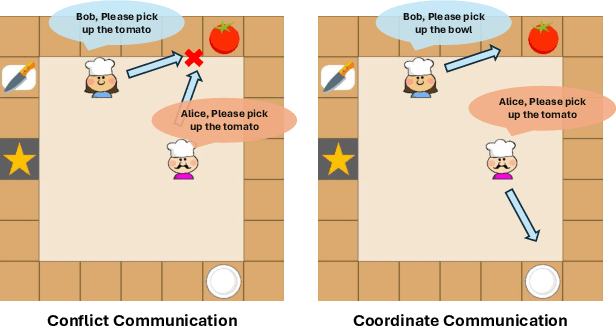
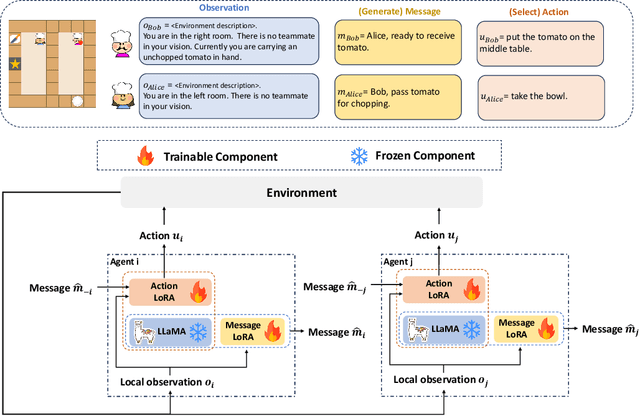
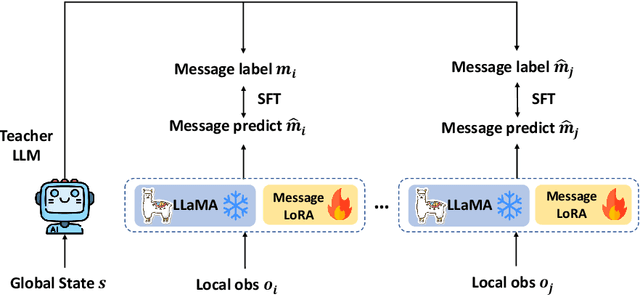

Abstract:In recent years, multi-agent reinforcement learning algorithms have made significant advancements in diverse gaming environments, leading to increased interest in the broader application of such techniques. To address the prevalent challenge of partial observability, communication-based algorithms have improved cooperative performance through the sharing of numerical embedding between agents. However, the understanding of the formation of collaborative mechanisms is still very limited, making designing a human-understandable communication mechanism a valuable problem to address. In this paper, we propose a novel multi-agent reinforcement learning algorithm that embeds large language models into agents, endowing them with the ability to generate human-understandable verbal communication. The entire framework has a message module and an action module. The message module is responsible for generating and sending verbal messages to other agents, effectively enhancing information sharing among agents. To further enhance the message module, we employ a teacher model to generate message labels from the global view and update the student model through Supervised Fine-Tuning (SFT). The action module receives messages from other agents and selects actions based on current local observations and received messages. Experiments conducted on the Overcooked game demonstrate our method significantly enhances the learning efficiency and performance of existing methods, while also providing an interpretable tool for humans to understand the process of multi-agent cooperation.
 Add to Chrome
Add to Chrome Add to Firefox
Add to Firefox Add to Edge
Add to Edge